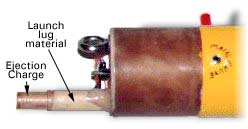High altitudes and parachute deployment at apogee don’t always mix unless you enjoy long walks or drives to recover a rocket. An alternative recovery method is to deploy a drogue at apogee to allow a rocket to fall at a relatively fast rate to a low altitude, like 1,000’ or 600’, where the main parachute is deployed. This type of recovery system is called two-stage recovery. The first stage is a quick, but controlled fall. The second stage is a slow descent under a parachute to touchdown.

A common design is to split a rocket into two pieces at apogee, with the pieces connected by a harness. An ejection charge controlled by an altimeter can be used to split the rocket where the payload section joins the fin can. One problem in rocketry is protecting the drogue and harness from the ejection charge. A simple design is presented here that will do that. It also requires less black powder than designs that require the whole airframe to be pressurized to separate the fin can and payload sections.
This design assumes that the fin can and payload sections are joined at about a rocket’s midpoint, the payload section contains the main parachute, and the drogue is deployed at the midpoint as shown below.
A coupler is used to join the fin can and payload sections during flight. A bulkhead is attached to the bottom of the coupler. The coupler can also be used to house electronics like an altimeter. An ejection charge holder is fastened to the bulkhead on the bottom of the coupler. A piece of 1/2” cardboard launch lug can be used as an ejection charge holder. A slot can be cut along its length for the ejection charge’s wires, and the ejection charge tube can be secured in place during flight with a wrap or two of masking tape.
Measure the length of the exposed coupler and position the containment tube to be the same distance below the top of the fin can’s top. The containment tube must be at least slightly longer than the ejection charge tube. A 6” long containment tube should be sufficient.
A bulkhead can be installed in the fin can’s airframe to be the bottom of the containment tube and for attachment of the harness. After the bulkhead has been installed, attach the containment tube to the airframe. Drop some epoxy down the containment tube to seal the bottom to the bulkhead so that hot gases don’t leak out to affect the harness or drogue.
The ejection charge tube should slide into the containment tube when the fin can and payload sections are joined. Test fit all parts before applying epoxy. The coupler’s bottom bulkhead should fit against the top of the containment tube, and the payload’s airframe should evenly meet the fin can’s airframe.

Pictured here is the bottom of a 2.6” diameter payload section. The coupler is used to house the altimeter that controls drogue and main parachute deployment. The drogue deployment charge is shown. (Phono plugs are used to activate the altimeter on the launch pad. Part of one plug (red) can be seen at the top of the picture, and the jack for another plug is in the center of the picture.)
The author has used this design with 2.6” and 4” diameter rockets, and it has worked perfectly each time. The author uses about 1/2 gram of black powder in the ejection charge. Larger diameter airframes may need multiple charges to prevent the couple from twisting and binding in the airframe.
Submitted by: Dean A. Roth